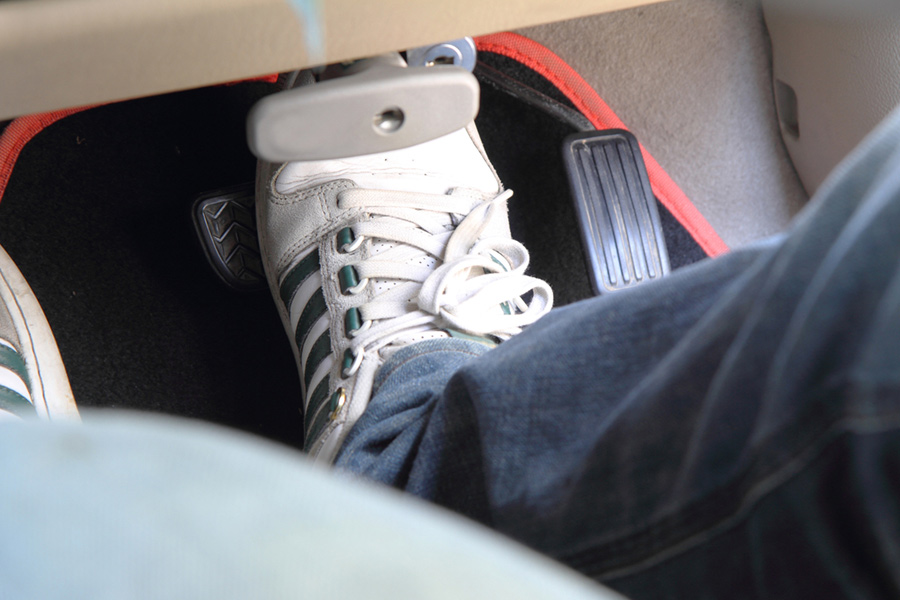Anti-lock braking systems (ABS) are electro-hydraulic systems designed to prevent the vehicle from spinning out of control during times when maximum brake pedal pressure is required. What you may not know is that the ABS accomplishes this task by rapidly deactivating and reactivating the braking system.
Most automotive braking systems basically utilize the same strategy. A power-assisted master cylinder (with fluid reservoir) forces high-pressure brake fluid through a series of metal and rubber brake lines into a cylinder or caliper at each wheel. The fluid actuates the cylinder or caliper which forces a set of pads or shoes against a drum or rotor that is affixed to the axle.
During a normal stop, the brake pedal is depressed firmly but gradually and the vehicle is brought to a gradual halt by the friction material (on the pads/shoes) which contacts the rotor/drum gradually on each axle. Do you see a pattern? Spoiler alert: it’s that the brake system works perfectly when gradual pressure can be applied.
Where the problem occurs is when there is no time for gradual pressure on the brake pedal, and a panic stop must be made. During these times, the brake pedal is typically jammed down with all the force the driver can muster in an all-out attempt to avoid a collision. What happens during these panic stops is that as the brake pedal is slammed towards the floor, the high pressure fluid forces the caliper/cylinder suddenly into service, and the friction material on the brake pads/shoes suddenly bites into the rotor or drum. This causes the wheel to suddenly stop moving. Since an object in forward motion tends to remain in forward motion (even though the wheel has suddenly stopped moving), once the wheel locks up, the tire slides across the pavement and the vehicle tends to continue moving forward—at its current rate of speed—with no particular sense of control. Sounds dangerous, right? Dangerous or not, automotive brakes worked that way for many decades.
So, the question became, not how to develop a new system of braking, but how to use the proven system more effectively. After all, the problem was not with stopping power or stopping the wheels from turning, but with control of the vehicle once the wheels locked up.
Enter anti-lock or anti-skid braking systems. These systems are aimed at preventing wheel lockup without reducing braking power. In order to accomplish this, high-pressure brake fluid would need to be pulsed between the master cylinder and each wheel. The trick was to pulse only the wheel that was locking up while maintaining steady pressure on the remaining wheels.
Primitive forms of anti-skid braking systems have been around since the early 1900s. Modern ABS systems are computer controlled and utilize wheel speed sensors to determine if any wheel lockup has occurred. Once wheel lockup has been detected, the ABS diverter pump is activated and brake fluid is delivered in a pulsing fashion (to the affected wheel) until the lockup issue has been rectified. The buzzing noise that is often heard during panic stops is the ABS pump motor running.
Let’s take a look at some basic ABS components and how they interact with each other:
ABS Control Module
Sometimes called the Electronic Brake Control Module (EBCM), this is most often an electro-hydraulic unit that includes a controller, the ABS pump, and the diverter (or dump) valves. The housing of the hydraulic unit doubles as a reservoir for diverted fluid which will be reintroduced into the brake lines when the pump is deactivated. The control module monitors wheel speed sensor input signals and activates the pump motor in the event of a wheel lockup. High-pressure brake fluid flows through this unit which is positioned between the master cylinder and the wheels.
Wheel Speed Sensors
Electromagnetic wheel speed sensors are positioned near each axle. They are positioned in close proximity to a reluctor ring that is affixed to an axle or brake rotor. As the teeth on the reluctor ring pass by the electromagnetic wheel speed sensor, a voltage waveform pattern is formed. The ABS control module recognizes this waveform pattern as vehicle speed. The controller is monitoring discrepancies (in speed) between the various axles or wheels. If one speed sensor input signal indicates that the corresponding wheel is in lockup, the controller will activate the ABS pump and high pressure brake fluid will be pulsed to that wheel until the lockup condition is rectified. Pressure should remain steady at the other wheels.
Keep in mind that there are nearly as many types of ABS systems as there are automobiles. This is only a basic overview of the ABS system.

